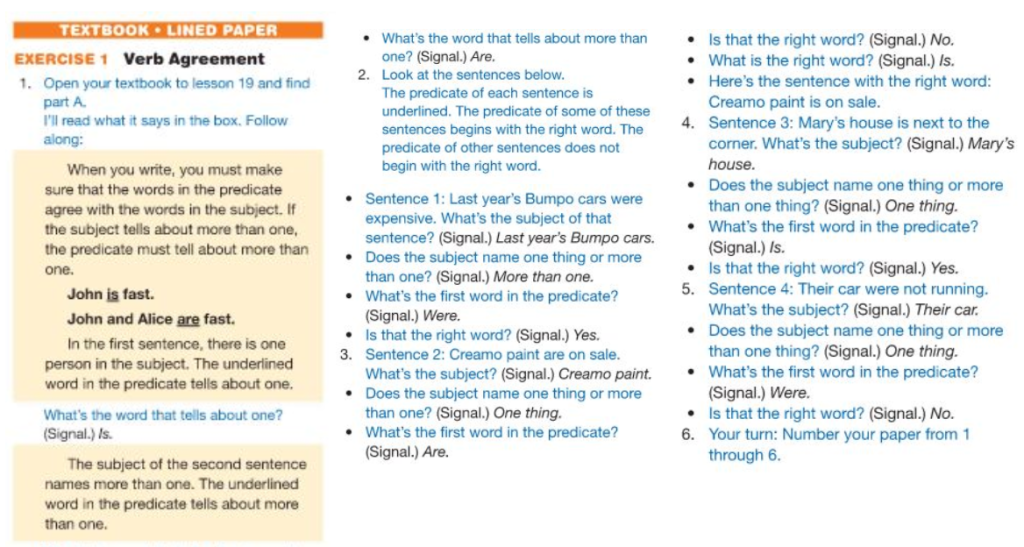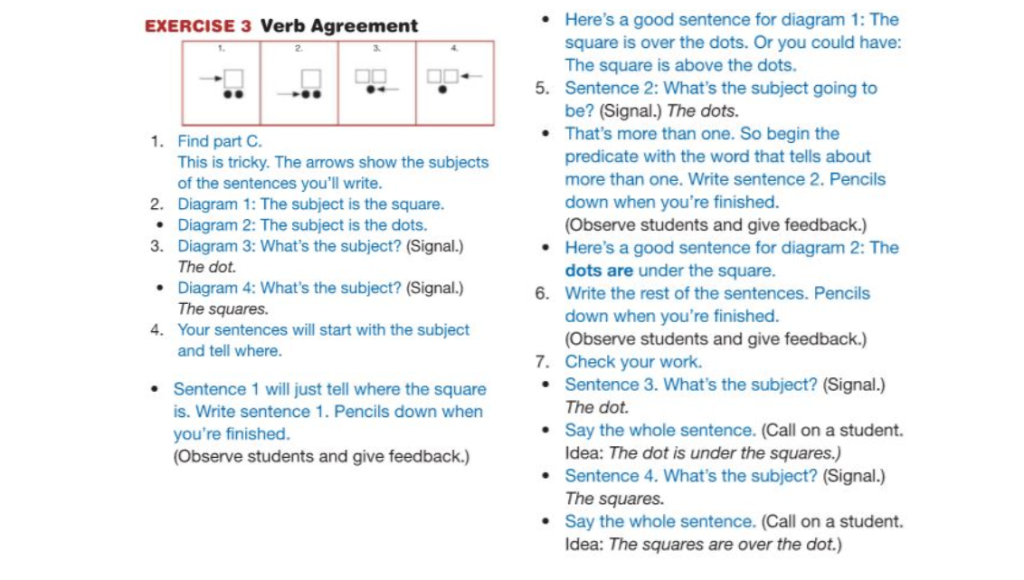Back to Course
Teach Reading Mastery Signature Edition: Language Arts: Year 3, 4 and 5
0% Complete
0/0 Steps
-
Module Introduction5 Topics
-
Overview22 Topics|1 Test
-
Cover
-
Lesson Objective
-
Opening the lesson
-
Direct Instruction overview
-
Who is it for
-
Program components
-
RMSE-LA 3 placement test specifics
-
RMSE-LA 4-5 placement test specifics
-
Placement test RMSE-LA 4
-
Grouping and seating
-
Teacher’s role in motivation
-
Affirmations
-
Teacher’s guides
-
Teacher’s guides continued
-
Script features
-
Star rules
-
Teacher-student game
-
Teacher-student game
-
Transitions
-
Check your understanding
-
Review
-
Lesson complete!
-
Cover
-
Managing Writing Activities23 Topics|1 Test
-
Cover
-
Lesson Objective
-
Opening the lesson
-
Managing writing activities explained
-
RMSE-LA 3 before students write
-
As students write
-
RMSE-LA 4-5 students’ oral reading of their writing
-
RMSE-LA 3 students check their passages
-
RMSE-LA 4-5 revising and editing
-
RMSE-LA 3 marking papers
-
RMSE-LA 4-5 marking papers
-
RMSE-LA 5 marking papers
-
Using the answer key in RMSE-LA 4-5
-
Positive praise
-
Specific praise
-
Using specific positive praise
-
Auditory signal
-
Auditory signal
-
Pacing of instruction
-
Pacing of instruction
-
Check your understanding
-
Review
-
Lesson Complete!
-
Cover
-
Parts of Speech and Sentence Analysis21 Topics|1 Test
-
Cover
-
Lesson Objective
-
Opening the lesson
-
Parts of speech and sentence analysis
-
Subject-predicate in RMSE-LA 3
-
Subject-predicate in RMSE-LA 4-5
-
Corrections
-
RMSE-LA 3 verb usage and identifying verbs
-
RMSE-LA 4 Verb agreement
-
Nouns
-
RMSE-LA 5 conjunctions, contractions and combining sentences
-
RMSE-LA 5 subject-verb agreement and two-word adjectives
-
RMSE-LA 3 pronoun usage
-
RMSE-LA 4 punctuation
-
RMSE-LA 3 pronouns, nouns and adjectives as parts of speech
-
RMSE-LA 5 nouns in the predicate, pronouns and pronoun case
-
Script success
-
RMSE-LA 5 Questions and Statements, adjectives and using position
-
Check your understanding
-
Review
-
Lesson Complete!
-
Cover
-
Clarity and General/Specific22 Topics|1 Test
-
Cover
-
Lesson Objective
-
Opening the lesson
-
Clarity in RMSE-LA 3-A
-
Clarity in RMSE-LA 3-B
-
Pause and punch
-
Clarity in RMSE-LA 4
-
Pronoun clarity
-
General/specific in RMSE-LA 4
-
Independent Work
-
Following directions – figure construction
-
Writing directions – figures and maps – 1
-
Active monitoring
-
Active monitoring
-
Unclear words
-
Unclear this/that
-
Phrase placement
-
Clear directions
-
General/specific
-
Check your understanding
-
Review
-
Lesson Complete!
-
Cover
-
Mechanics, Editing, Reporting and Inferring in RMSE LA 318 Topics|1 Test
-
Sentence Types and X Boxes17 Topics|1 Test
-
Cover
-
Lesson Objective
-
Opening the lesson
-
The tick
-
Sentence types
-
Statements consistent with impressions
-
Combining sentences
-
Comparative sentences
-
More sentence types
-
Pause and punch
-
Droning and corrections
-
X boxes for directions
-
Different X box format for directions
-
X-boxes format for claims
-
Check your understanding
-
Review
-
Lesson Complete!
-
Cover
-
Arguments and Passage Writing18 Topics|1 Test
-
Cover
-
Lesson Objective
-
Opening the lesson
-
Arguments described
-
False dilemmas
-
Infer missing evidence
-
Faulty arguments
-
Accordion box
-
Arguments continued
-
Script success
-
Corrections
-
RMSE-LA 4-5 revising and editing
-
Narrative writing
-
Extended passage writing symbols
-
Extended passage writing
-
Check your understanding
-
Review
-
Lesson Complete!
-
Cover
-
Retell and Parallel Construction20 Topics|1 Test
-
Cover
-
Lesson Objective
-
Opening the lesson
-
Retell overview
-
Prompted retells
-
Taking notes for retell
-
Using category words
-
Auditory signal
-
Auditory signal
-
Teacher demonstrating errors when signalling
-
Parallel construction – using also
-
Using only
-
Vocabulary
-
Descriptions
-
Deductions
-
Writing the missing sentence
-
Pacing of instruction
-
Check your understanding
-
Review
-
Lesson Complete!
-
Cover
-
Expanded Writing Process, Writing and Research Unit19 Topics|1 Test
-
Cover
-
Lesson Objective
-
Opening the lesson
-
Expanded writing process
-
RMSE-LA 3 marking papers
-
Expanded writing process continued
-
RMSE-LA 3 students check their passages
-
Writing and research unit
-
RMSE-LA 4-5 marking papers
-
Writing and revising stories
-
RMSE-LA 4-5 revising and editing
-
Writing reports and giving speeches
-
Reference materials
-
Study skills
-
Vocabulary
-
Punctuation and grammar
-
Check your understanding
-
Review
-
Lesson Complete!
-
Cover
-
Writing and Response To Literature16 Topics|1 Test
-
Cover
-
Lesson Objective
-
Opening the lesson
-
Writing
-
Inaccuracies
-
Misleading claims
-
Contradictions
-
Inadequate evidence
-
Mystery object
-
False cause and arguments with conclusions that are too general
-
Hypothesis testing
-
More-probable inferences and planning/decisions
-
Response to literature
-
Check your understanding
-
Review
-
Lesson Complete!
-
Cover
-
Extensions, Further Activities and Projects14 Topics|1 Test
-
Cover
-
Lesson Objective
-
Opening the lesson
-
Language Arts extensions
-
Using resource materials and study skills
-
Usage and grammar, word analysis and word-analysis extensions
-
Positive praise
-
Further activities
-
Specific praise
-
Using specific positive praise
-
Projects (team activities)
-
Check your understanding
-
Review
-
Lesson Complete!
-
Cover
-
Program Assessments22 Topics
-
Cover
-
Lesson Objective
-
Opening the lesson
-
Mastery tests
-
Conducting mastery tests
-
Scoring the test
-
Using mastery test information
-
Mastery test criterion
-
Providing test remedies
-
Remediation and retesting how it is done
-
Mastery tests on SPT
-
Inputting data on SPT
-
Flight path concept
-
Expected lesson pacing
-
Lesson progress on SPT
-
Pacing of instruction
-
Effective transitions
-
Teaching routines for effective transitions
-
Teaching routines
-
Teaching and reinforcing routines and expectations
-
Review
-
Lesson Complete!
-
Cover
-
Module Completion Survey1 Topic
Participants 580
Lesson 4,
Topic 9
In Progress
RMSE-LA 4 Verb agreement
ddewell@goodtogreatschools.org.au August 7, 2023
Lesson Progress
0% Complete

RMSE-LA 4 Verb agreement
Students in RMSE-LA 4 learn the rule about verb agreement. The rule is: if the subject tells about one, the predicate must tell about one.
If the subject tells about more than one, the predicate must tell about more than one. Exercises dealing with verb-agreement begin in lesson nineteen.
Beginning in lesson fifty students work with squares and dot figures to construct simple sentences with subject verb agreement. Students apply the rule that the number in the subject controls the number for the predicate.

The process is:
- The teacher says, ‘This part is tricky. The arrows show the subjects of the sentences you’ll write. Diagram one: the subject is the square. Diagram two: the subject is the dots. Diagram three: What’s the subject?’ and signals (auditory). ‘Diagram four: What’s the subject?’ and signals (auditory).
- The teacher says, ‘Your sentence will start with the subject and tell where. Sentence one will just tell where the square is. Write sentence one. Put your pencils down when you are finished’, and observes students and gives feedback.
- The teacher says, ‘Here’s a good sentence for diagram one: The square is over the dots. Or you could have: The square is above the dots.’
- The teacher continues with the sentences for the other three figures.
Exercises



